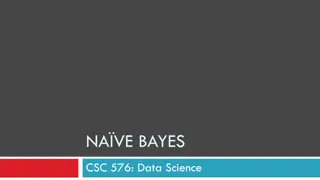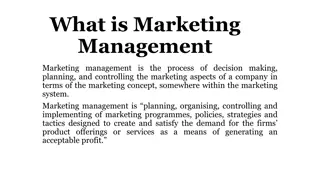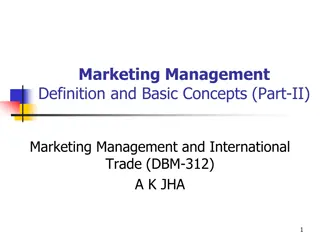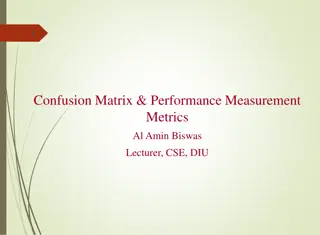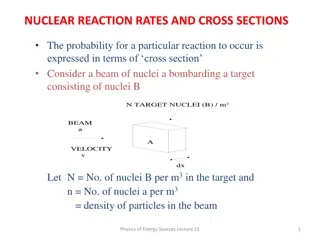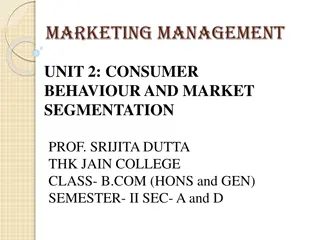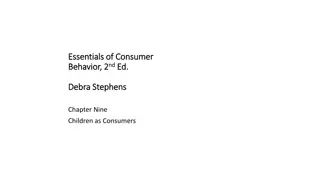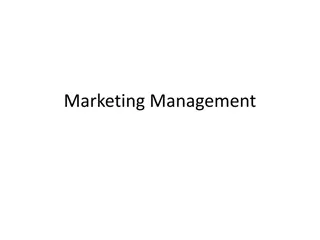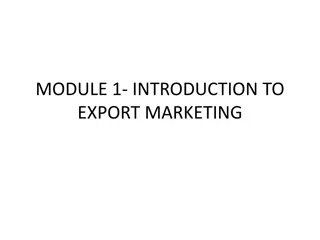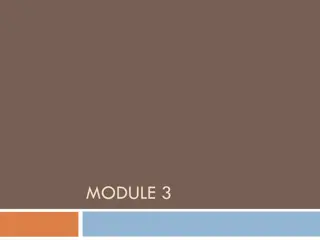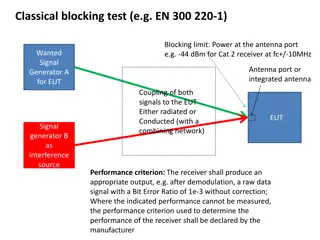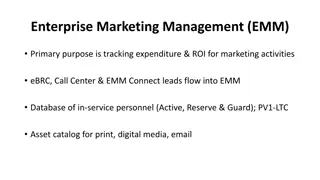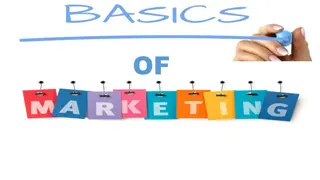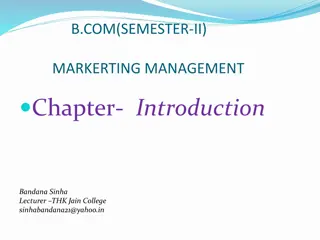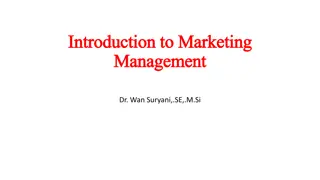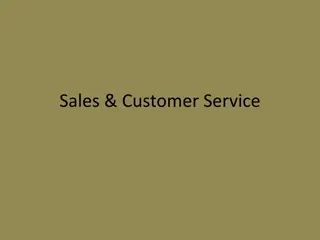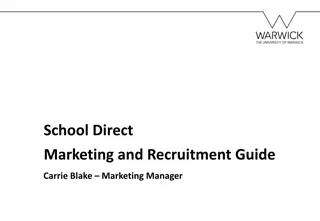Understanding Classifier Performance in Target Marketing
Explore the importance of classifier performance in target marketing scenarios such as direct marketing, consumer retention, credit scoring, and bond ratings. Learn how to efficiently allocate resources, identify high-value prospects, and evaluate classifiers to maximize profit in marketing campaigns.
Download Presentation

Please find below an Image/Link to download the presentation.
The content on the website is provided AS IS for your information and personal use only. It may not be sold, licensed, or shared on other websites without obtaining consent from the author. Download presentation by click this link. If you encounter any issues during the download, it is possible that the publisher has removed the file from their server.
E N D
Presentation Transcript
Eco 6380 Predictive Analytics For Economists Spring 2016 Professor Tom Fomby Department of Economics SMU
Presentation 11 Judging Classifier Performance In Target Marketing Problems Chapter 5 in SPB
Where Ranking of Cases are Important Direct Marketing Target Marketing: You want to efficiently allocate your advertising budget to contact high- probability consumers first. Consumer, Employee, and Student Retention: You want to identify those people who are likely to leave your service first so that you can intervene effectively to keep the person. Credit Scoring and Loan Pricing: Knowing who is a good credit risk and a bad credit risk and charging differential interest rates on loans to compensate for differences in risk. Bond Ratings of Municipalities: The higher the probability of default the lower the bond rating.
The Evaluation and Utilization of Classifiers in Typical Target Marketing Problems A. Typical Target Marketing Scenario B. The Case of the Known Target Marketing Payoff (Profit) Matrix C. Cumulative Profit Curves Derived from Scoring Test Data Sets D. The Case of Unknown Profit Matrix Must rely on Cumulative Gains and Lift Charts to evaluate competing classifiers.
Typical Target Marketing Scenario You have 10,000 potential customers you would like to send catalogues to but you only have a budget large enough to send to 1,000 customers. Who should you send your catalogues to in order to maximize your profit? The Typical Direct Marketing Profit (Payoff) Matrix: R= Average Profit of catalogue purchases per customer, C = Cost of Mailing Catalogue Here we assume there is no opportunity cost in missing out on a person who would have otherwise made a purchase from your catalogue. First, we use a classifier to prearrange the 10,000 customers from highest probability of purchase to lowest probability of purchase. Then we form the Cumulative Profit Curve. See the following slide for an example. Predicted Value 1 0 0 1 R-C Actual value 0 -C 0
Explanation of Figure 5.9 in SPB 10,000 People are in a Test Data Set. A classifier is used to order the individuals from highest probability of purchase to lowest probability of purchase. In theory then, one can imagine soliciting these ordered individuals and one-by-one observing whether they purchase from our catalogue or not. This process leads to the cumulative profit chart that you see in Figure 5.9. (An actual empirical version of this curve is going to be much rougher than this. For example, the figure below represents two cumulative profit curves arising from using two different classifiers in a given Test Data Set.)
Explanation of Figure 5.9 in SPB 10,000 People are in a Test Data Set. A classifier is used to order the individuals from highest probability of purchase to lowest probability of purchase. In theory then, one can imagine soliciting these ordered individuals and one-by-one observing whether they purchase from our catalogue or not. This process leads to the cumulative profit chart that you see in Figure 5.9. Notice here that there is no decision made at this point on choosing a Cutoff Value for the classifier. We are just trying to see how many ordered potential customers we need to solicit in order to maximize the profit derived from the solicitation. Here the maximum profit ($1,500) is obtained by soliciting up to and including the 3,000thperson. Of course, we know the probability of purchase, say ? , associated with this zero marginal profit (3,000th) person and we can use this threshold in subsequent target marketing uses of the classifier. In Figure 5.9 we also notice that if we sample the entire 10,000 potential customer solicitation base we wind up losing money ($1,500). Toward the end of the customer base we have run into potential customers who have very low probabilities of purchase and correspondingly have chosen not to make any purchases from the catalogue that was received. This point emphasizes the importance of prioritizing customer solicitation. The Reference Line in the diagram goes from the origin to the Total Net Benefit Point. In this drawing SPB assumes an Average Revenue Value, R, of $25, a cost of mailing, C, of $0.65, the number of customers to potentially solicit to be N = 10,000 and the overall total response rate to be 2%. In this case the expected net benefit of mailing to all 10,000 customers (the Net Total Benefit Point) is (0.02 x $25 x 10,000) ($0.65 x 10,000) = $5,000 - $6,500 = - $1,500.
Choosing Between Classifiers based on the Cumulative Profit Curves In theory each classifier will have a Cumulative Profit Chart like you see in the next slide and thus an implied optimal stopping the solicitation probability value associated with the Cumulative Profit Curve. Alternatively, one could look at the maximum cumulative profit point and determine the depth to which you went into the Test Data set before reaching the maximum cumulative profit, for example, 4,000 of the 10,000 sorted potential customers resulting in a depth of 40%. To the extent the Test Data set is typical of data sets yet to be scored, one can use such criteria. The best classifier for this Target Marketing problem is the classifier that produces the Maximum Cumulative profit on the Test Data while noting the corresponding stopping probability (or scoring depth) associated with this profit point. This classifier, with its associated stopping probability (scoring depth) can be used on the next scoring data set with the hope of approximating the superior performance it had on the Test Data set.
Comparison of Cumulative Profit Curves for Two Competing Classifiers Left is Cumulative Profit Curve for Classifier One Right is Cumulative Profit Curve for Classifier Two Which Classifier is Preferred? What should its Cutoff Value Be? We should choose the Classifier that has the maximum cumulative profit. Here it is the one on the right.
Comparison of Superior and Inferior Cumulative Profit Charts
What do you do when you dont have a Profit Matrix but yet are interested in maximizing early successes as in Target Marketing? You examine the early parts of Cumulative Lift Charts and Decile-by-Decile Lift Charts. We are now going to use some graphs and formulas from the file Lift Charts.pdf .
When the Payoff Matrix of a Target Marketing Problem is Unknown, comparisons of classifiers are usually carried out by comparing the Cumulative Gains Charts and Lift Charts of the Competing Classifiers.
Example for Generating Cumulative Gain and Lift Charts http://www2.cs.uregina.ca/~dbd/cs831/notes/lift_chart/lift_chart.html A company wants to do a mail marketing campaign. It costs the company $1 for each item mailed. They have information on 100,000 customers. Create a cumulative gains and a lift chart from the following data. Overall Response Rate: If we assume we have no model other than the prediction of the overall response rate, then we can predict the number of positive responses as a fraction of the total customers contacted. Suppose the response rate is 20%. If all 100,000 customers are contacted we will receive around 20,000 positive responses. Cost ($) Total Customers Contacted Positive Reponse 100,000 100,000 20,000
Example: Using this data, see if you can duplicate the numbers in Cumulative Gains and Cumulative Lift Charts depicted in the next two charts. Cost ($) Total Customers Contacted Positive Responses 10000 10000 6000 20000 20000 10000 30000 30000 13000 40000 40000 15800 50000 50000 17000 60000 60000 18000 70000 70000 18800 80000 80000 19400 90000 90000 19800 100000 100000 20000
Cumulative Gains and Lift Charts for Example Data Cumulative Gains Chart: The y-axis shows the percentage of positive responses. This is a percentage of the total possible positive responses (20,000 as the overall response rate shows). The x-axis shows the percentage of customers contacted, which is a fraction of the 100,000 total customers. Baseline (overall response rate): If we contact X% of customers then we will receive X% of the total positive responses (20,000).
Cumulative Gains Chart for Example Data
Comparing Cumulative Gains Charts: Example: There are 100 subjects to classify. 25% of them are positive respondents. In the below chart the cumulative gains curve of the perfect classifier is (1). The cumulative gains curve of the na ve classifier is (2). The cumulative gains curve of classifier (3) is uniformly better than the cumulative gains curve of classifier (4). Then the area under each cumulative gain is a measure of the performance of each classifier. Let the area of the perfect classifier be normalized at 1. Area under (3) > Area under (4) > Area under (2). A normalized measure of performance for classifier (3), for example, would be 0 < Area(3)/Area(1) < 1. The closer to one this normalized measure is, the better the classifier. As no cutoff probability is applied or implied in drawing the Cumulative Gains curves of classifiers (3) and (4), these two classifiers, via the areas under their respective Cumulative Gains Curves, can be compared straight away. A decision can be made as to which classifier is better with no reference to a cutoff value. The greater the area under the Cumulative Gains curve of a classifier, the better the classifier is. The Cumulative Gains curves allow a pure comparison between competing classifiers. Note: In this chart it assumed that, for each classifier (except the na ve one), the customers have been separately sorted from the highest probability of a positive response to the lowest probability of a positive response from left to right on the % customers contacted (X) axis.
Lift Chart for Example Data Lift Chart: Shows the actual lift. To plot the chart: Calculate the points on the lift curve by determining the ratio between the result predicted by the model and the result using no model. Example: For contacting 10% of customers, using no model we should get 10% of responders and using the given model we should get 30% of responders. The y-value of the lift curve at x = 10% is 30 / 10 = 3.
Decile-by-Decile Lift Chart versus Cumulative Lift Chart: The Decile-by-Decile Lift Chart represents, decile by decile, the ratio of the positive responses in each decile using a given classifier to the number of positive responses expected in each decile when using the na ve classifier. The Cumulative Lift Chart represents the ratio of the cumulative positive responses up to and including a given decile using a given classifier to the corresponding cumulative positive responses when using the na ve classifier. The two charts convey the same information but in different forms. It should be noted that these Lift Charts are not dependent on a Cutoff Probability and thus the Lift Charts of competing classifiers can be directly compared. We prefer the classifiers with the higher first and second decile lift ratios.
Summary: Cumulative Profit Curves and Cumulative Gains Charts and Lift Curves Cumulative Profit Curves are useful for comparing Classifiers in Targeting Marketing problems when the Payoff matrix is known (usually the average profit per solicitation (R) and the cost of solicitation (C)). One chooses the classifier that maximizes the cumulative profit of a solicitation with a corresponding stopping probability chosen for the next solicitation. Cumulative Gains and Lift curves are most useful for classifier comparisons when the Payoff Matrix is not known. (In the case of unknown Payoff Matrices, cumulative profit curve comparisons are no longer possible.) Cumulative Lift curves and Decile-by-Decile Lift curves are equivalent in the information that they contain. For companies on limited advertising budgets, the greater the first and second Decile Lift Ratios, the better. Note: ROC Curves are drawn by varying the cutoff (threshold) value of a classifier from 1.0 to 0.0 while looking at what happens to the combination of False Positive rates (X-axis) and True Positive rates (Y-axis). In contrast, the Cumulative Profit and Gains Curves and Lift Curves are determined by applying a classifier to construct an ordered customer solicitation list starting with the highest probability of purchase customers and moving through to the lowest probability of purchase customers. Although Target Marketing classifiers can be rated by the Area under ROC curves or by the ???accuracy measure, it would appear that the use of the Cumulative Profit Curve or Cumulative Gains and Lift Curves would be more useful for evaluating classifiers intended for use in Target Marketing problems.


